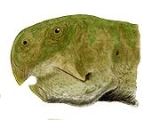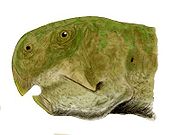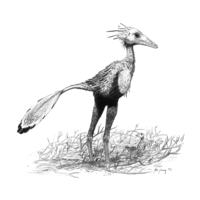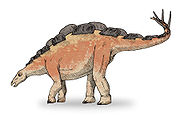
Ejinhoro Formation
Encyclopedia
The Ejinhoro Formation is a geological formation in Inner Mongolia
, north China
, whose strata date back to the Early Cretaceous
period.
Dinosaur remains are among the fossils that have been recovered from the formation.
Indeterminate pterosaur
remains have also been recovered from it.
Inner Mongolia
Inner Mongolia is an autonomous region of the People's Republic of China, located in the northern region of the country. Inner Mongolia shares an international border with the countries of Mongolia and the Russian Federation...
, north China
People's Republic of China
China , officially the People's Republic of China , is the most populous country in the world, with over 1.3 billion citizens. Located in East Asia, the country covers approximately 9.6 million square kilometres...
, whose strata date back to the Early Cretaceous
Early Cretaceous
The Early Cretaceous or the Lower Cretaceous , is the earlier or lower of the two major divisions of the Cretaceous...
period.
Dinosaur remains are among the fossils that have been recovered from the formation.
Dinosaurs
| Dinosaur Dinosaur Dinosaurs are a diverse group of animals of the clade and superorder Dinosauria. They were the dominant terrestrial vertebrates for over 160 million years, from the late Triassic period until the end of the Cretaceous , when the Cretaceous–Paleogene extinction event led to the extinction of... s of the Ejinhoro Formation |
||||
|---|---|---|---|---|
| Taxa | Presence | Notes | Images | |
Genus:
|
Isolated teeth. |
A sauropod. |
    |
|
Genus:
|
A ceratopsia Ceratopsia Ceratopsia or Ceratopia is a group of herbivorous, beaked dinosaurs which thrived in what are now North America, Europe, and Asia, during the Cretaceous Period, although ancestral forms lived earlier, in the Jurassic. The earliest known ceratopsian, Yinlong downsi, lived between 161.2 and 155.7... n. |
|||
|
Order:
|
A large saurischian. | |||
|
Genus:
|
"Near-complete articulated skeleton." |
A troodontid Troodontidae Troodontidae is a family of bird-like theropod dinosaurs. During most of the 20th century, troodontid fossils were few and scrappy and they have therefore been allied, at various times, with many dinosaurian lineages... . |
||
Family:
|
Isolated teeth. |
A stegosaurid. |
||
Genus:
|
A large stegosaurid. "Partial skeleton, plate, vertebra, adult." | |||
Indeterminate pterosaur
Pterosaur
Pterosaurs were flying reptiles of the clade or order Pterosauria. They existed from the late Triassic to the end of the Cretaceous Period . Pterosaurs are the earliest vertebrates known to have evolved powered flight...
remains have also been recovered from it.

